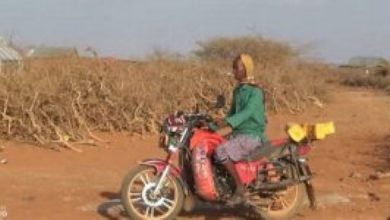As other African countries ban donkey slaughter, Kenya doubles down to meet Chinese demand
Twice a month, Julius Yebei, 45, embarks on a three-day journey by foot with a herd of donkeys from a livestock market in Bomet County to Goldox, a donkey slaughterhouse located in the semi-arid Kenyan county of Baringo.
Twice a month, Julius Yebei, 45, embarks on a three-day journey by foot with a herd of donkeys from a livestock market in Bomet County to Goldox, a donkey slaughterhouse located in the semi-arid Kenyan county of Baringo.
The $6 million Chinese-owned donkey export slaughterhouse is one of three to open in Kenya in the last 18 months. Since the opening of the abattoirs, which process hundreds of donkeys a day, the price of an adult donkey in the country has soared to between $90 and $130 from $40 in less than two years.
Yebei’s twice-monthly trek, herding fifteen donkeys at a time, is a ritual he’s become accustomed to since the abattoir opened last year. It’s also become his primary source of income.
“Before this facility was opened, I used to deal in cattle, goats, sheep, and chicken,” he says. “But, it has now given us a good market for donkeys.”
In the space of only a few years, the export of donkey skins and meat to China has ramped up in Africa, presenting both a major opportunity and threat to local farmers. The animals are used in ejiao, a traditional Chinese remedy, and in some areas, as a delicious, nutritious food source. The Donkey Sanctuary, a UK-based charity, puts the annual demand for donkeys at 10 million, a quarter of the estimated global population. China had about 11 million donkeys about two decades ago, they now number about six million. It has turned to Africa in recent years to make up the shortfall.
So great is the demand for the export of the animals that several African countries have banned donkey slaughter in response to widespread poaching, and to mitigate the impact on local farmers, who rely on the animals for their livelihood. As a result, theft and cross-border smuggling is rife, particularly into Kenya, where donkey slaughter remains legal. Traders use informal routes, and official statistics on smuggling are nonexistent. But abattoirs admit Kenya’s neighbors are a major supply point.
“There are donkeys that are brought in from as far as Somalia,” says Lu Dong Lin, the managing director of Goldox. “Many of the donkeys that are brought to the slaughterhouse by traders from the border regions actually come from across the border, especially from Tanzania.”
Will donkeys go the way of elephants?
In Kenya, the absence of organized breeding programs has raised concerns among abattoir owners, traders, vets, and animal rights activists that the donkey population in the country could be wiped out in a decade or less. About 400 donkeys are slaughtered at the existing abattoirs daily.
“With the huge demand in China, the country’s donkey population is now in danger,” says Dr Samuel Kahariri, a chairperson of the Kenya Veterinary Association, an industry lobby group, and member of the Kenya Veterinary Board, a government body that regulates the livestock sector.
Animal rights activists in Kenya say that over the last year, at least 100,000 donkeys were slaughtered at abattoirs. Some are killed illegally by poachers and passed off as beef in the local market, where eating donkey meat is considered taboo.
Syndicates illegally capture and cruelly kill the animals before skinning them in bushes or makeshift abattoirs. Botswana, Burkina Faso, Mali, Niger, and Senegal have banned exports of donkey products in recent years as a result. In April, following local protests against donkey slaughter, Ethiopia, home to an estimated 7.4 million donkeys, banned donkey skin trade and retracted the license of a Chinese-owned abattoir in the country, saying it was “against [the] values and culture of the society.” Tanzania followed suit in May.
To fight illegal donkey killings, Kenya, which recorded about 1.8 million asses in a 2009 census, requires the animals to be slaughtered only in licensed abattoirs. Traders are required to bear clearance certificates from vets and local chiefs as a safeguard against thefts or cross-border spread of diseases. Slaughterhouses also only buy live donkeys—and are not permitted to buy the animal’s skins alone.
Undaunted by these rules and faced with dwindling supplies, some Kenyan traders are smuggling donkeys in from neighboring countries. After a safe passage into Kenya through its porous borders, the traders acquire permits from local authorities before transporting them to abattoirs.
“I usually buy them in Tanzania and then move them into Kenya through informal routes,” one trader tells Quartz. Lately, he says, he isn’t guaranteed on getting adequate stock from Tanzania to meet his 60 donkeys-per-week target. On noticing the donkeys are taken for slaughter and export to China, the sellers in Tanzania decided to raise prices, he says.
Sell your livelihood, or face having it stolen
These informal supply chains are hurting rural economies. Donkeys remain a central part of life in many rural areas throughout Africa, supporting people’s participation in sectors ranging from agriculture and transport, to tourism and construction. But the prospect of immediate income, and the threat of theft, have forced many households to consider their sale. A few years ago, donkeys roamed freely across the country, nibbling at grass, awaiting their next call of menial duty. Now, they’re being driven to abattoirs in droves.
Dennis Koskei’s farming household in Elgeyo Marakwet has been a victim of such thefts. After one incident, when three donkeys were stolen in one night, Koskei was able to trace them to the slaughterhouse in Baringo. After learning of the theft, he immediately hopped onto a motorbike and traversed the neighboring villages in a frantic search. Locals advised him to rush to the slaughterhouse, where he found the animals outside. Owners usually identify their lost animals from unique markings they make on their bodies.
“Our intention is not to sell them as they are important to our livelihoods but we didn’t know somebody could steal and bring them here,” Koskei says.
Lin says the abattoir has a strict policy of not slaughtering the animals within about 24 hours of delivery. “Normally, we keep them in the barn overnight or sometimes, for much longer, before slaughtering them. This gives us an opportunity to iron out any cases involving thefts reported to us,” he says. Donkeys identified to have been stolen are usually rejected by the abattoir, the culprit arrested and handed over to police.
Kenyan officials see investment in the abattoirs as positive, providing new business for livestock keepers, and employment opportunities in local communities. The three slaughterhouses have a combined workforce of about 550 workers.
The slaughterhouses “create employment for the many Kenyans who have no jobs, as well as create wealth,” says Dr. Dulu Thomas Daido, the acting director of veterinary services in the ministry of Agriculture Livestock and Fisheries.
With the donkey population dwindling, the focus is now shifting to commercial breeding programs, which until now, have failed to meet surging demand. Two of the donkey abattoirs in Kenya are already running small-scale programs. Goldox has a hundred-acre farm for breeding the animals, a short distance from the abattoir.
“If we are to continue being in business and to sustain the market, we have to do breeding and rearing of donkeys on a massive scale,” John Kariuki, the managing director of one abattoir, says.
Dr. Daido shares such sentiments, but believes the abattoirs should be leading breeding programs that incorporate farmers across the country.
“The worry has been about the potential of donkey population getting depleted. But, we have had such discussions and come to a consensus that we need to ensure the slaughterhouses start recruiting farmers to do donkey breeding to multiply their populations,” he tells Quartz. “If they start doing so, it will be a whole new enterprise that has not been previously explored.”
This work was produced as the result of a grant provided by the Africa-China Reporting Project, managed by the Journalism Department of the University of the Witwatersrand.





